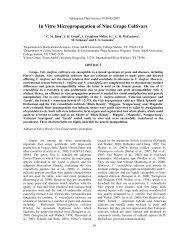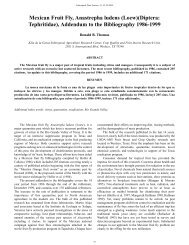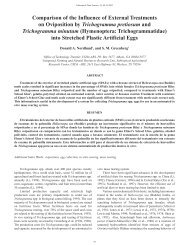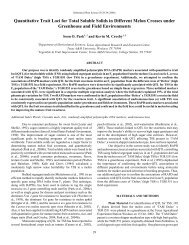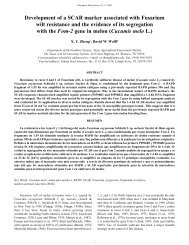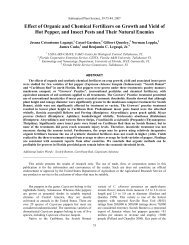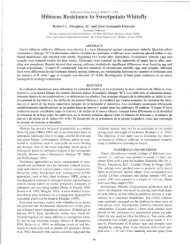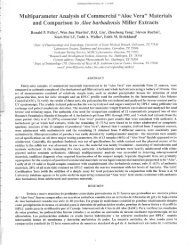Jian-Long Bi and Nick C. Toscano - Subtropical Plant Science Society
Jian-Long Bi and Nick C. Toscano - Subtropical Plant Science Society
Jian-Long Bi and Nick C. Toscano - Subtropical Plant Science Society
Create successful ePaper yourself
Turn your PDF publications into a flip-book with our unique Google optimized e-Paper software.
<strong>Subtropical</strong> <strong>Plant</strong> <strong>Science</strong>. 57:1-4. 2005<br />
insecticides with a novel mode of action. Insect resistance to other<br />
insecticides may not result in cross-resistance to this insecticide<br />
<strong>and</strong> strains resistant to other insecticides might be more sensitivive<br />
to this chemistry (Scott et al. 2004). Therefore, chlorfenapyr is<br />
potentially a potent component in IPM programs to control the beet<br />
armyworm (Wier et al. 1994). Chemical control is still an<br />
important component of IPM systems. In California, growers rely<br />
on conventional insecticides such as methomyl, chlorpyrifos <strong>and</strong><br />
pyrethroids to control the beet armyworm on various crops.<br />
Widespread tolerance to some of these compounds has been<br />
reported in California <strong>and</strong> other areas (Brewer <strong>and</strong> Trumble 1989,<br />
1994, Brewer et al. 1990; Mascarenhas et al. 1998). Introducing<br />
<strong>and</strong> alternating emamectin benzoate <strong>and</strong> chlorfenapyr into the<br />
current beet armyworm management programs will be strategic to<br />
alleviate the risk of insecticide resistance. The results of this study<br />
can also serve as baselines for resistance monitoring programs.<br />
ACKNOWLEDGEMENTS<br />
We thank John Trumble (University of California, Riverside) for<br />
supplying beet armyworm for this study <strong>and</strong> Shu-Tang Zhou for<br />
technical assistance. This research was supported in part by<br />
California Iceberg Lettuce Advisory Board.<br />
REFERENCES CITED<br />
Abbott, W.S. 1925. A method for computing the effectiveness<br />
of an insecticide. J. Econ. Entomol. 18: 265-267.<br />
Black, B.C.; R.M. Hollingworth, K.I. Ahammadsahib, C.D.<br />
Kukel, <strong>and</strong> S. Donovan. 1994 Insecticidal action <strong>and</strong><br />
mitochondrial uncoupling activity of AC-303,630 <strong>and</strong><br />
related halogenated pyrroles. Pesticide <strong>Bi</strong>ochem. Physiol.<br />
50: 115-128.<br />
Brewer, M.J., <strong>and</strong> J.T. Trumble. 1989. Field monitoring for<br />
insecticide resistance in beet armyworm (Lepidoptera:<br />
Noctuidae). J. Econ. Entomol. 82: 1520-1526.<br />
Brewer, M.J., <strong>and</strong> J.T. Trumble. 1994. Beet armyworm<br />
resistance to fenvalerate <strong>and</strong> methomyl: resistance variation<br />
<strong>and</strong> insecticide synergism. J. Agric. Entomol. 11: 291-300.<br />
Brewer, M.J., J.T. Trumble, B. Alvarado-Rodriguez, <strong>and</strong> W.E.<br />
Chaney. 1990. Beet armyworm (Lepidoptera: Noctuidae)<br />
adult <strong>and</strong> larval susceptibility to three insecticides in<br />
managed habitats <strong>and</strong> relationship to laboratory selection for<br />
resistance. J. Econ. Entmol. 83: 2136-2146.<br />
Brown, E.S., <strong>and</strong> C.F. Dewhurst. 1975. The genus Spodoptera<br />
(Lepidoptera, Noctuidae) in Africa <strong>and</strong> the Near east. Bull.<br />
Entomol. Res. 65: 221-262.<br />
Byrne, F.J., <strong>and</strong> N.C. <strong>Toscano</strong>. 2001. An insensitive<br />
acetylcholinesterase confers resistance to methomyl in the<br />
beet armyworm Spodoptera exigua (Lepidoptera:<br />
Noctuidae). J. Econ. Entomol. 94: 524-528.<br />
Cox, D.L., A.L. Knight, D.G. <strong>Bi</strong>ddinger, J.A. Lasota, B.<br />
Pikonuis, L.A. Hull, <strong>and</strong> R.A. Dybas. 1995. Toxicity <strong>and</strong><br />
field efficacy of avermectines against colding moth<br />
(Lepidoptera: Tortricidae) on apples. J. Econ. Entomol. 88:<br />
708-715.<br />
Deng, Y., <strong>and</strong> J.E. Casida. 1992. Housefly head GABA-gated<br />
chloride channel: toxicological relevant binding site for<br />
avermectines couples for ethynyl-bicycloortho benzoate.<br />
Pesticide <strong>Bi</strong>ochem. Physiol. 43: 116-122.<br />
Dunbar, D.M, R.D. Brown, J.A. Norton, <strong>and</strong> R.A. Dybas. 1996.<br />
Proclaim: a new insecticide for use on cotton, pp. 756-758.<br />
In P. Dugger <strong>and</strong> D. Richer (eds.). Proc. Beltwide Cotton<br />
Research Conf. Natl. Cotton Council of Am, Memphis, TN.<br />
Fischer, M.H., <strong>and</strong> H. Mrozik. 1989. Chemistry, pp. 105-124.<br />
In W.C. Campbell, (ed), Ivermectin <strong>and</strong> abamectin.<br />
Springer, Berlin Heidelberg New York.<br />
Hoy, M.A., <strong>and</strong> F.E. Cave. 1985. Laboratory evaluation of<br />
avermectin as a selective acaricide for use with Metasciulus<br />
occiddentalis (Nesbitt) (Acarina: Phytiseiidae). Exp. Appl.<br />
Acarol. 1: 139-152.<br />
Ishaaya, I., S. Kontsedalov, D. Mazirov, <strong>and</strong> A.R. Horowitz.<br />
2001. <strong>Bi</strong>orational agents – mechanism <strong>and</strong> importance in<br />
IPM IRM programs for controlling agricultural pests. Med.<br />
Fac. L<strong>and</strong>bouww. Univ. Gent. 66: 363-374.<br />
Jansson, R.K., R.F. Peterson, W.R. Halliday, P.K. Mookerjee,<br />
<strong>and</strong> R.A. Dybas. 1996. Efficacy of solid formulations of<br />
emamectin benzoate at controlling lepidopterous pests.<br />
Florida Entomol. 79: 434-449.<br />
LeOra Software. 1987. POLO-PC. A user’s guide to probit or<br />
logit analysis. LeOra Software, Berkeley, CA.<br />
Liburd, O.E., J.E. Funderburk, <strong>and</strong> S.M. Olson. 2000. Effect of<br />
biological <strong>and</strong> chemical insecticides on Spodoptera species<br />
(Lep., Noctuidae) <strong>and</strong> marketable yields of tomatoes. J.<br />
Appl. Ent. 124: 19-25.<br />
Mascarenhas V.J., J.B. Graves, B.R. Leonard, <strong>and</strong> E. Burris.<br />
1998. Susceptibility of field populations of beet armyworm<br />
(Lepidoptera: Noctuidae) to commercial <strong>and</strong> experimental<br />
insecticides. J. Econ. Entomol. 91: 827-833.<br />
Mitchell, E.R. 1979. Migration by Spodoptera exigua <strong>and</strong><br />
Spodoptera frugiperda North America Style, pp. 386-395.<br />
In Rabb <strong>and</strong> Kennnedy (eds.). Movement of highly mobile<br />
insects: concepts <strong>and</strong> methodology. University Graphics,<br />
North Carolina State University, Raleigh, NC.<br />
Patana, R. 1985. Sopdoptera exigua, pp. 465-469. In P. Singh<br />
<strong>and</strong> R. F. Moore (eds.), H<strong>and</strong>book of insect rearing.<br />
Elsevier, Amsterdam.<br />
Scott, J.G., C.A. Leichter, <strong>and</strong> F.D. Rinkevich. 2004.<br />
Insecticide resistance strains of houseflies (Musca<br />
domsetica) show limited cross-resistance to chlorfenapyr. J.<br />
Pesticide Sci. 29: 124-126.<br />
Smits, P.H., M.C. Van Velden, M. Van De Vrie, J.M. Vlak.<br />
1987. Feeding <strong>and</strong> dispersion of Spodoptera exigua larvae<br />
<strong>and</strong> its relevance for control with nuclear polyhedrosis virus.<br />
Entomol. Exp. Appl. 43: 67-72.<br />
Wier, A.T., D.J. Boethel, B.R. Leonard, <strong>and</strong> E. Burris. 1994.<br />
Laboratory toxicity <strong>and</strong> field efficacy of AC 303,630<br />
(Pirate) against beet armyworm, Spodoptera exigua<br />
(Hubner), larvae. J. Agric. Entomol. 11: 311-320.<br />
Yee, W L., <strong>and</strong> N.C. <strong>Toscano</strong>. 1998. Laboratory evaluations of<br />
synthetic <strong>and</strong> natural insecticides on beet armyworm<br />
(Lepidoptera: Noctuidae) damage <strong>and</strong> survival on lettuce. J.<br />
Econ. Entomol. 91: 56-63.<br />
4



